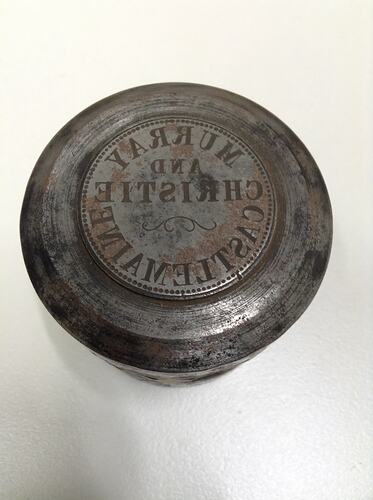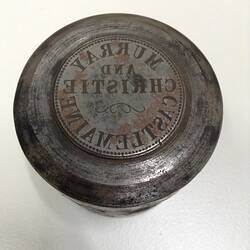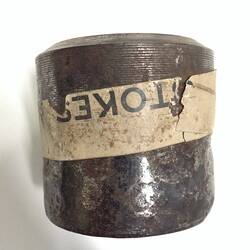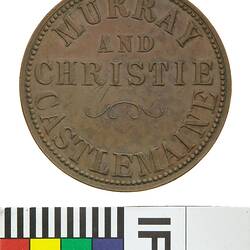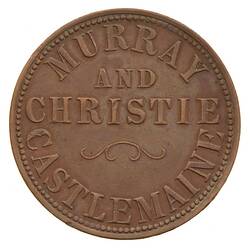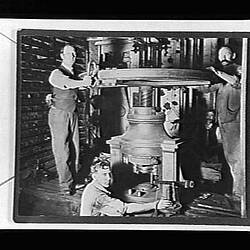Summary
Steel One Penny Token Die, made by Thomas Stokes, Melbourne, 1862. Used for tokens issued by Murray & Christie, Castlemaine. In 1857 Murray joined Christie's business as a salesman. In 1861 they built another more substantial building on the same site. Unfortunately for them, when business slowed in Castlemaine in 1865 they had invested in the town heavily, purchasing a flour mill. They speculated in a range of pastoral, mining and property investments, all to their loss. David Murray became insolvent in 1871. Both men left Castlemaine in 1875, having speculated without much gain.
Previous Collections: National Gallery of Victoria
Physical Description
A steel die 55 mm high with a base diameter of 54 mm and a working surface diameter of 34 mm. The die features the name and address of the issuer: Murray and Christie, Castlemaine. Although the working face of the obverse is undamaged (other than slight rusting) the main body of the die is surrounded by a series of deep indentations apparently made while trying to fix the die in the press. This is the only die in the collection so damaged and suggests that the steel was soft. See Notes tab for discussion of the overall issues of Murray & Christie.
Obverse Description
Legend in four lines, the first and last curved, MURRAY / AND / CHRISTIE / - / CASTLEMAINE (mirror incuse) border of 113 beads
More Information
-
Collecting Areas
-
Acquisition Information
Transfer from National Gallery of Victoria (NGV), 15 Mar 1976
-
Date Issued
1862 AD
-
Issued By
-
Mint
Stokes (Mint), Melbourne, Greater Melbourne, Victoria, Australia, 1862
-
Commissioned By
-
Previous Collection
Numismatics Collection, National Gallery of Victoria (NGV), pre 1976
-
Inscriptions
MURRAY AND CHRISTIE CASTLEMAINE (mirror incuse)
-
Denomination
-
Series
-
Material
Steel
-
Classification
-
Category
-
Discipline
-
Type of item
-
Dimensions
52 mm (Height), 54 mm (Outside Diameter)
-
Shape
Cylinder
-
References
The company of Murray and Christie arranged with Stokes for the manufacture of their trade tokens in 1862. There was some trouble with both the obverse and reverse dies during the production. The first reverse die cracked and was replaced, with the two dies being identified in standard catalogues by the small differences in the relative positions of the lettering, a simple test involves the length of the word GROCERS and the postion of the letter R in GROCERS above the letters in the word IRONMONGERS:
-
Keywords
Glass, Grocers, Ironmongers, Numismatic Dies, Numismatic Technology, Retail Trade, Retailing
